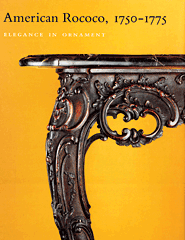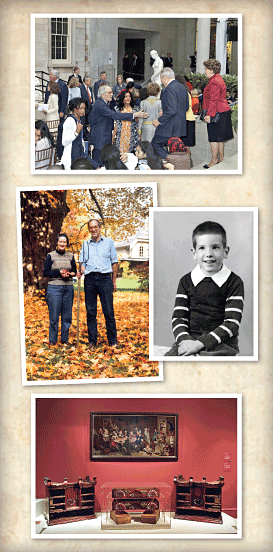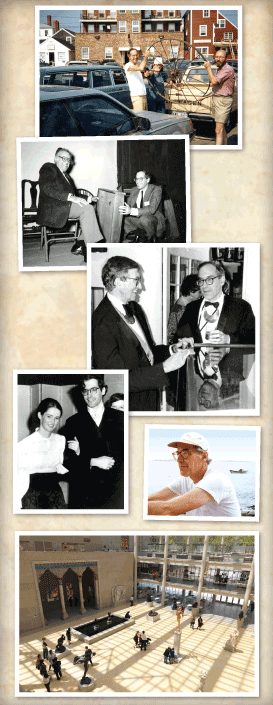 |
| Home | Articles | 2011 ADA Award of Merit Recipient: Morrison H. Heckscher |
 |
 |
by Amelia Peck
|
 |
 |
This year’s honoree of the ADA Award of Merit is Morrison H. Heckscher, the Lawrence A. Fleischman Chairman of the American Wing at The Metropolitan Museum of Art. A scholar of eighteenth-century American furniture and eighteenth- and nineteenth-century American architecture, Morrie is universally liked and admired by museum professionals and patrons alike.
 |
 |
 |
Catalogue for the exhibition American Rococo: Elegance in Ornament, 1750–1775 (with Leslie Greene Bowman, 1992).
|
From his school days growing up in Philadelphia, Morrie remembers with fondness the shop classes taught by his teacher Erwin Drexel at the Episcopal Academy in Merion, which inspired him to dream of becoming a cabinetmaker. In his words, “I dabbled at woodwork,” and was very proud of a copy of an early nineteenth-century tripod table that he made as a high schooler. With his usual self-deprecating humor, Morrie admits he’d chosen a second rate example to emulate.
As an American history student at Wesleyan University in Middletown, Connecticut, Morrie became “entranced” by American architecture of the eighteenth and nineteenth centuries. Although Morrie chose American History as his major, his most influential professor was Samuel M. Green, an art historian and a painter. During Morrie’s senior year in college in 1962, he contemplated the traditional career choices that many of his classmates were making, and says that he realized he “was singularly unsuited to be a lawyer or a businessman.” Morrie accepted Professor Green’s suggestion that he apply to the Winterthur Program in Early American Culture. It was the right fit. Charles F. Montgomery, who became Morrie’s mentor, was in the midst of writing his noted catalogue of the Federal furniture in Winterthur’s collection. He encouraged Morrie to write his MA thesis on the cabinetmakers of Federal-era Philadelphia. When Montgomery suggested he do his PhD at Yale or Columbia, Morrie chose Columbia in part because of his welcoming interview with famed art historian Rudolph Wittkover, who told him at their first meeting (and Morrie says the next quote with a heavy German acccent) “Ven you come in the fall, ve vill vork out the details.” The details were that he would be studying English art and architecture, and write his dissertation on William Kent’s architecture and interiors.
|
 |
|
 |
 |
 |
 |
IMAGES FROM TOP: Morrison H. Heckscher, the Lawrence A. Fleischman Chairman of The American Wing, welcomes Metropolitan Museum honorary trustee, The Honorable William Lee Lyons Brown, Jr., former Ambassador of the United States to the Republic of Austria, and his wife Alice Carey to the ribbon-cutting ceremony in The Charles Engelhard Court. In the background are Met trustee Richard L. Chilton, Jr., and his wife Maureen; Anthony W. Wang; Richard and Elizabeth Miller; and Met trustee Lulu C. Wang. © The Metropolitan Museum of Art. 2009.
With Fenella at The Vyne, ca. 2000.
Childhood Photo, ca. 1946.
Installation of John Townsend, Newport Cabinetmaker (2005), Morrie’s most recent exhibition and publication. © The Metropolitan Museum of Art.
|
In 1966, Morrie received a Chester Dale Fellowship to work on the English architectural drawings in The Metropolitan Museum’s Print Department, and in 1968, putting his dissertation on hold, he accepted an offer from American Wing curator Berry B. Tracy to become assistant curator and work on a catalogue of the museum’s eighteenth-century American furniture collection. Yet almost immediately he was pulled away to assist Tracy on the groundbreaking exhibition Nineteenth Century America (1970) and an accompanying exhibition The Rise of American Architecture. Soon after, the idea gained traction for an enlarged American Wing with galleries for American paintings and to expand the decorative arts collections through to the beginning of the twentieth century.
Morrie’s mission during the 1970s was to collect important pieces for the new wing by the big three of late-nineteenth-century architecture: Henry Hobson Richardson, Louis Sullivan, and Frank Lloyd Wright. He was successful in two out of the three; today the American Wing is the proud home to two wonderful staircases designed by Louis Sullivan for the Chicago Stock Exchange (1893) and the serenely beautiful living room from the Little House in Wayzata, Minnesota, (1913–1915) by Frank Lloyd Wright. Morrie’s good friend Christopher Monkhouse, Chair and Eloise W. Martin Curator at the Art Institute of Chicago, remembers, “When Morrie was negotiating with the Little family descendants, they met him at the Minneapolis airport in the winter of 1971 for a visit to the house. In order to break the ice, Morrie felt the need to make some light conversation, starting with the observation on how pleased he was to find himself in the middle of winter in Indianapolis! The fact that the museum eventually acquired the room is a testament to Morrie’s residual diplomatic skills, and the fact that Morrie has continued to tell this story suggests that he doesn’t take himself too seriously.”
Morrie’s mission during the 1970s was to collect important pieces for the new wing by the big three of late-nineteenth-century architecture: Henry Hobson Richardson, Louis Sullivan, and Frank Lloyd Wright. He was successful in two out of the three; today the American Wing is the proud home to two wonderful staircases designed by Louis Sullivan for the Chicago Stock Exchange (1893) and the serenely beautiful living room from the Little House in Wayzata, Minnesota, (1913–1915) by Frank Lloyd Wright. Morrie’s good friend Christopher Monkhouse, Chair and Eloise W. Martin Curator at the Art Institute of Chicago, remembers, “When Morrie was negotiating with the Little family descendants, they met him at the Minneapolis airport in the winter of 1971 for a visit to the house. In order to break the ice, Morrie felt the need to make some light conversation, starting with the observation on how pleased he was to find himself in the middle of winter in Indianapolis! The fact that the museum eventually acquired the room is a testament to Morrie’s residual diplomatic skills, and the fact that Morrie has continued to tell this story suggests that he doesn’t take himself too seriously.”
|
 |
|
|
|
 |
 |
 |
 |
IMAGES FROM TOP: Damariscotta, Maine, with Christopher Monkhouse, ca. 1990.
With Harold Sack at Old Sturbridge Village, 1985.
With Wendell Garrett, ca. 1995.
Maine, 1985.
With Fenella at The Metropolitan Museum of Art Centennial Ball, 1970.
The renovated Charles Engelhard Court, completed in 2009 as Phase II of the American Wing overhaul.
© The Metropolitan Museum of Art.
|
When the new wing opened in 1980, Morrie returned to working on the American eighteenth-century furniture catalogue (1985), for which, in combination with some other writings, he received his PhD from Columbia in lieu of his long-ago proposed dissertation on William Kent. That year he was also the winner of the Charles F. Montgomery Award from the Decorative Arts Society. Subsequently, Morrie went on to write articles and books and mount such memorable shows as The Architecture of Richard Morris Hunt (1986), American Rococo: Elegance in Ornament, 1750–1775 (with Leslie Greene Bowman, 1992), and John Townsend, Newport Cabinetmaker (2005). Two of his favorite projects were the museum Bulletins he wrote in 1995 on the architectural history of The Metropolitan Museum and “Creating Central Park” in 2008.
Among Morrie’s greatest frustrations were the shortcomings of the 1980 wing in terms of the display of the museum’s great American collections. When he became the chairman of the American Wing in 2001, he began to focus on how to make the Wing a more satisfying experience for visitors. What started as a modest ambition soon morphed into a multi-phase project that has improved almost every part of the Wing. Says Morrie, “Little did I dream that this project would end up taking ten years and costing one hundred million dollars, but the experience of working with a great architect, great trustees, and the best colleagues imaginable has been enormously rewarding.”
Phase I opened in 2007, with the newly remodeled Classical Galleries highlighting American Federal and neoclassical furniture; Phase II in 2009, with the entirely redesigned Courtyard, intended to showcase the collection of American sculpture and architectural elements, a new mezzanine balcony level and integrated installations of silver, glass, and ceramics, and a rethought suite of eighteenth-century period rooms, complete with digital room labels. Phase III, the rebuilt paintings galleries, will open in mid-January 2012. Metropolitan Museum trustee Lulu Wang says, “Morrie’s passion for the “new” American Wing at The Met goes far beyond just a professional interest. He truly feels he has a calling to present America’s greatest collection of fine and decorative arts in a setting it deserves, and to have visitors leave the collection with a renewed appreciation of its beauty and historic importance.”
|
 |
|
 |
In his private life, Morrie counts himself extremely lucky to have married the wise and wonderful Dr. Fenella Grieg in 1974. They enjoy gardening and working on their somewhat eccentric Gothic Revival weekend home “The Vyne,” in Newburgh, New York, and are happiest when hosting their large extended family of nieces and nephews.
All images courtesy Morrison Heckscher unless otherwise specified.
|
 |
|
|
|
 |
 |
Amelia Peck is the Marica F. Vilcek Curator, Department of American Decorative Arts and Manager, The Henry R. Luce Center for the Study of American Art at The Metropolitan Museum of Art, New York, NY.
|
 |
|
|
|
 |
 |
The ADA Award of Merit is selected by the board of directors of the ADA (Antiques Dealers Association of America) and is presented to an individual who has made a significant contribution to the field of American antiques. The Award of Merit dinner will be held at the Philadelphia Antiques Show at 8 p.m. on Saturday, April 9. It will feature cocktails and dinner followed by a variety of guest speakers and friends The ADA Award of Merit is sponsored in part by Antiques & Fine Art Magazine, Antiques & The Arts Weekly, Flather and Perkins Insurance, The Magazine Antiques, and Mizzentop Transport. Seating is limited; tickets are $90 per person. For additional information and reservations call the ADA at 203.364.9913 or send your request to: Antiques Dealers’ Association of America, Inc., P.O. Box 529, Newtown, CT 06470-0529.
The ADA is a nonprofit trade association. Its major objective is to further professionalize the business of buying and selling antiques. Its membership is composed of antiques dealers who are dedicated to integrity, honesty, and ethical conduct in the antiques trade. All members are required to guarantee their merchandise in writing on a sales receipt that states approximate age, origin, condition, and any restoration of pieces sold.
|
 |
|
 Download the Complete Article in PDF Format Download the Complete Article in PDF Format    Get Adobe Acrobat Reader Get Adobe Acrobat Reader
|
 |
 |
|
|